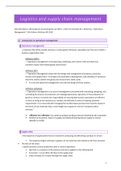Logistics and supply chain management
Alle informatie is afkomstig van de powerpoints van Mevr. Limère en het boek W.J. Stevenson, "Operations
Management" 13th Edition, McGraw-Hill 2018
1) Introduction to operations management
Operations management:
= processes that either provide services or create goods. Moreover, operations are the core of what a
business organization does.
- Definition APICS:
= “Operations management is the planning, scheduling, and control of the activities that
transform inputs into finished goods and services”
- Definition MIT:
= “Operations Management deals with the design and management of products, processes,
services and supply chains. It considers the acquisition, development, and utilization of resources
that firms need to deliver the goods and services their clients want.
Ø It is not only about the management, but also the design of these systems.
- Definition wikipedia:
= “Operations management is an area of management concerned with overseeing, designing, and
controlling the process of production and redesigning business operations in the production of
goods or services. It involves the responsibility of ensuring that business operations are efficient
in terms of using as few resources as needed, and effective in terms of meeting customer
requirements. It is concerned with managing the transformation process that converts inputs (in
the forms of raw materials, labor, and energy) into outputs (in the form of goods and/or
services).”
Ø efficient AND effective: You need to produce products that are desired by the customers
Ø Achieve an economic match of supply and demand (having excess supply or excess
capacity is costly)
Supply chain
= the sequence of organizations that are involved in producing and delivering a product or service.
Ø The sequence begins with basic suppliers of raw materials and extends to the final customer
• The links of the chain:
= would represent various production and/ or service operations.
Ø Each link is a customer of the previous link and a supplier to the following link
Ø If one fails -> it can affect the flow in the supply chain
Ø Value increases as it moves through the supply chain
1
, • The chain present:
1. The sequential nature of a supply chain
2. The interconnectedness of the elements of the supply chain.
• Supply chains are both external and internal to the organization:
o External part provides raw materials, parts, equipment.. and deliver outputs to the customers
o Internal part are the operations function.
è Supplying operations with parts and materials, performing work on products, and/or
performing services.
OM= managing transformation processes
• Inputs: land, labor, capital, information, goods
Ø Using one or more transformation processes -> outputs are obtained
• Feedback:
= the organization takes measurements at various points in the transformation process
• Control:
2
, = compares those measurements with previously established standards to decide if corrective action is
needed.
• The essence of the operations function:
= to add value during the transformation process.
Ø Value-added:
= the term used to describe the difference between the cost of inputs and the value or price
of outputs.
ð The greater the value-added, the greater the amount of funds available for these
purposes.
• Different kinds of operations:
a) Typical material processors:
= transforms raw materials into goods and services
Ø E.g. food production, postal services, automotive etc.
b) Typical information processors:
= transform an amount of data into an information report.
Ø E.g. accountants, financial analysts
c) Typical people processors:
= transforms people
Ø E.g. an hospital, hairdresser, mass rapid transports, theatres, theme parks...
Production of goods vs. delivery of services
• Goods:
= are physical items that include raw materials, parts, subassemblies, and final products.
Ø Production of goods -> tangible output
Ø Can take place in a factory or elsewhere e.g. restaurant
• Services:
= are activities that provide some combination of time, location, form, or psychological value.
Ø Implies an act
a. Degree of customer contact:
3
, = high degree pf contact, the interaction between server and customer becomes a “moment of truth”
that will be judged by the customer every time the service occurs.
b. Labor content of jobs:
= services often have a higher degree of labor content, although automated services are an exception.
c. Uniformity of inputs:
= manufacturing operations often gave a greater ability to control the variability of inputs -> more
uniform job requirements
d. Measurement of productivity:
= more difficult for service jobs due largely to high variations of inputs.
e. Quality assurance:
= more challenging for services due to the higher variation in input, and because delivery and
consumption occur at the same time.
f. Inventory:
= services cannot be stored
g. Wages:
= manufacturing jobs are often well paid, and have less wage variation than service jobs, which can
range from highly paid professional services to minimim-wage workers.
h. Ability to patent:
= some services cannot be patented, making them easier to copy.
• The goods-service continuum:
Goods and services often occur jointly
E.g. having the oil changed in your car is a service, but the oil itself is a good.
Manufacturing matters!
Many service activities are essential in goods-producing companies.
There is a shift from the manufacturing sector to the service sector towards a knowledge economy.
Many services exist to support manufacturing. Manufacturing itself leads to innovation and a return of
innovations comes after research and development.
Decision horizon
4




